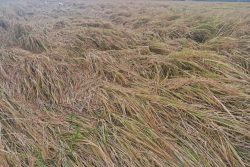The proposed collaborative public-private initiative to have a rice flour factory operational by the beginning of the second rice harvest is still far from reality.
The site of the factory is yet to be determined, although Agriculture Minister Dr Leslie Ramsammy has stated that rice flour markets are being sought by the ministry.
Stabroek News understands that there are no immediate plans, once the factory is operational, to supply the local market. Ramsammy said the policy for the project is still being compiled and that the long-term goals were to incorporate 20% cassava, plantain, rice or even breadfruit with wheat flour.
The factory will operate with the intention being to eventually transition ownership to rice farmers. Ramsammy told Stabroek News that unlike traditional cooperatives, which have not proven successful in Guyana for commodity products in the past such as rice, farmers will have ownership. However the daily operations of the factory will have to be taken on by a management staff that is technically trained.
Over the weekend, Ramlakhan and Sons Rice Mill at Exmouth, Essequibo Coast did a test run of the rice husk gasifier, as an alternative energy concept.
A release from the ministry said Ramlakhan and Sons Rice Mill purchased the Gastrification Plant in part to reduce on energy costs.
The plant arrived late last year and the installation and successful testing were recently completed. The rice husk will fuel the gasifier and the gases emitted are swept of solid particles, tar/carbon and water/moisture, and directed into the combustion chambers of a 250 KW power generating set, replacing 70% of the diesel required to run the generator, the release said.
Ramlakhan was quoted in the release as saying that this will greatly reduce his energy cost and improve his viability at a time when rice prices on the international market are on the decline.
This will also allow him to keep paying a competitive price to the farmers for their paddy, the release added.
The gasifier initiative stems from the government’s low carbon thrust. As part of this drive, the Government of Guyana and The Energy and Resources Institute (TERI) of India signed a Memorandum of Understanding on May 25 2011. During initial studies, TERI found that the energy cost component in rice production was over 35%. The release said that the cost of energy accounts to close to US$15.50 per metric tonne of paddy processed.
This is mainly due to the use of diesel for power generation. Minimal use was being made of the rice husk and this lack of use also created an environmental problem.








